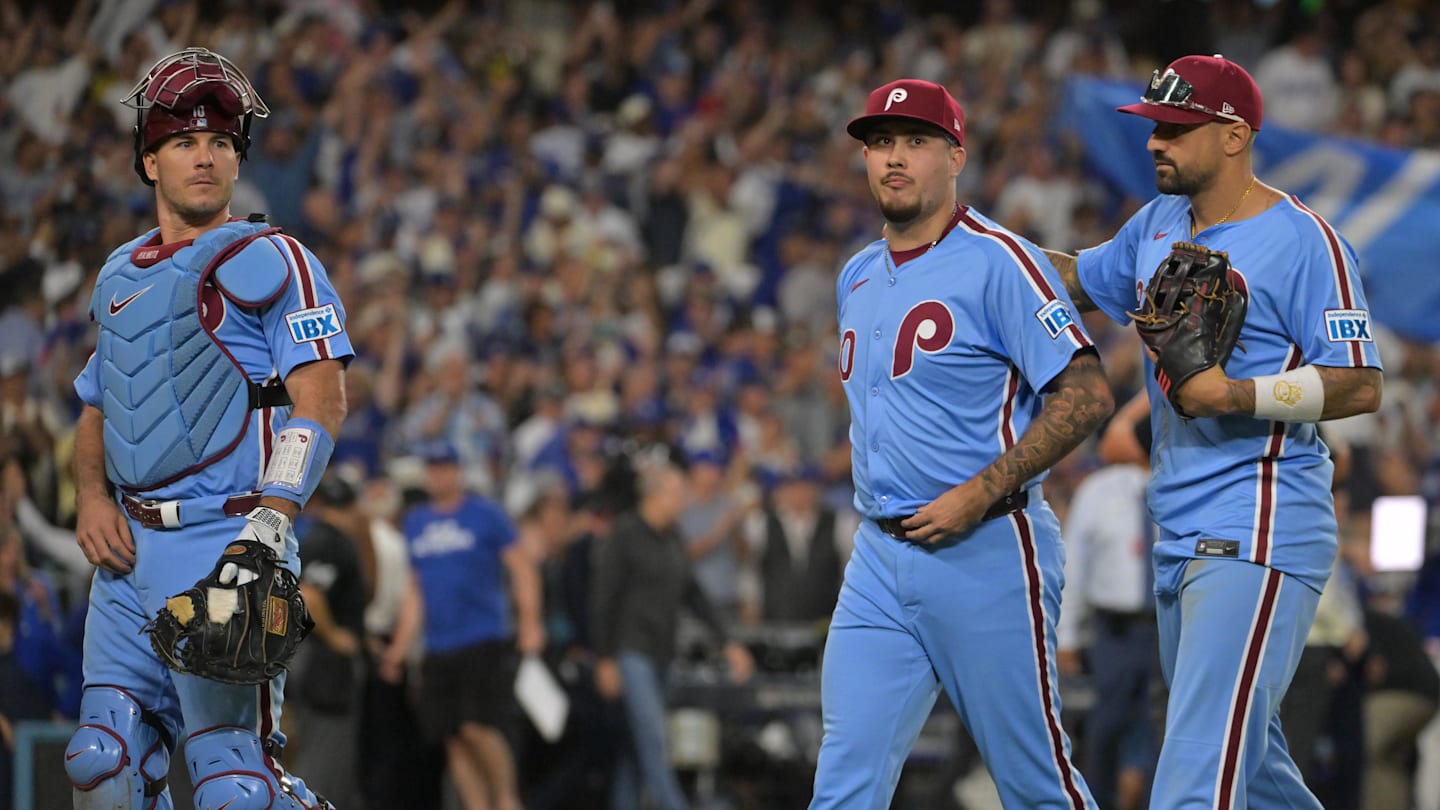LOS ANGELES — Philadelphia Phillies reliever Orion Kerkering booted a groundball and threw wildly to home plate, when an easier out was available at first base, as the Los Angeles Dodgers captured a series-clinching 2-1 walk-off win Thursday night at Dodger Stadium.
Kerkering’s error on Andy Pages’ 40-foot bouncer with two outs and the bases loaded in the 11th inning ended a madcap game and series between two National League titans.
The Dodgers, vying to be the league’s first back-to-back World Series champion in a quarter century, will face the Milwaukee Brewers or Chicago Cubs in the National League Championship Series.
The game was a pitchers’ duel until the seventh inning, when Nick Castellanos roped a run-scoring double to left field, and the Dodgers answered with Mookie Betts drawing a bases-loaded, two-out, full-count walk against Phillies closer Jhoan Duran. As both managers emptied the tank, Duran covered five outs, and Dodgers rookie closer Roki Sasaki threw three perfect innings.
A WALK-OFF TO MOVE ON TO THE NLCS. pic.twitter.com/JPveGti3Nu
— Los Angeles Dodgers (@Dodgers) October 10, 2025
Manager Rob Thomson went to Kerkering with two outs in the 11th. The right-hander walked Kiké Hernández, then induced the ill-fated dribbler off the bat of Pages.
Phillies avoid Shohei Ohtani, but Jhoan Duran cracks
Jhoan Duran faced 81 batters after a summer trade brought him to the Phillies. He walked only one of them. He had walked two of the nine Dodgers batters he faced earlier in this series, but Duran is the portrait of command. He pounds the strike zone.
That is why, with an open base, the Phillies chose to put Shohei Ohtani on first. They loaded the bases in the seventh inning. Ohtani had been 2-for-6 with two homers and two walks against Duran in his career. Although Ohtani had not produced all series, the Phillies made a logical choice. They weren’t going to let Ohtani beat them.
Then Duran walked Mookie Betts on six pitches. It was the first time in his career Duran walked in a run.

Jhoan Duran was uncharacteristically wild in the seventh inning, walking in a run for the first time in his career. (Ronald Martinez / Getty Images)
The Phillies were backed into a corner in the bottom of the seventh after a Nick Castellanos double put them ahead in the top half. They wanted Cristopher Sánchez to carry them through the seventh, but a walk to Alex Call and a Kiké Hernandez single forced Thomson’s hand. Sánchez might have had Call struck out, but a borderline call did not go his way.
So, in the seventh, the Phillies went to their closer. They could not have expected a walk.
As the game extended and extended, the Phillies had to dip into their rotation. They summoned scheduled Game 5 starter Jesús Luzardo for the 10th inning. He was pitching on two days’ rest. He recorded five outs but ran into trouble in the 11th. That’s when the Phillies summoned Kerkering, who had warmed up numerous times throughout the game.
Kerkering walked Kiké Hernández to load the bases. He either forgot how many outs there were or panicked, and that is when it all ended for the Phillies.
It was the most bitter of defeats for a Phillies team that matched Los Angeles punch for punch but fell short.
In Roki, the Dodgers trust
It bears repeating that just more than a month ago, Roki Sasaki was not a remotely important part of the Dodgers’ 2025 plans. Now, they cannot live without him.
That much was true even before he sprang into action in the bottom of the seventh inning, warming up quickly as the Dodgers finally broke through for the tying run against Cristopher Sánchez and Jhoan Durán. The Dodgers rode Sasaki for an eight-pitch eighth inning before doing something they hadn’t done with him yet since converting him to relief — sending him out for a second inning. When that went well, they kept him in there for extras for a third inning. This was a hurdle the Dodgers didn’t know Sasaki would be able to clear as a reliever. This is all still so new.
Sasaki passed with flying colors, retiring all nine batters he faced and regularly sitting at 100 mph with his fastball.
Tyler Glasnow shows up
For Tyler Glasnow, this October is an odd place to be. He was acquired with the postseason in mind a year ago, only for the Dodgers to win the World Series without him. Glasnow has missed time because of to injury, battled himself on the mound, and, in between, shown flashes of pure brilliance.
In his first postseason start in a Dodgers uniform, Glasnow showed all he was promised to be. Over six shutout innings, he overpowered a Phillies lineup that had roared to life the night before. His fastball touched 99 mph, overwhelming hitters with how close he released the pitch toward home plate.
This was the version of Glasnow the Dodgers dreamed of, and not gotten as often as they’d like. But the performance comes at the right time for the local product, as the pitcher from Hart High School (Santa Clarita, Calif.) put together an electric outing in which he struck out eight.
Phillies cannot capitalize on offensive momentum from Game 3
The Phillies padded their lead late in Game 3 with contributions from everyone in their lineup, and for the first time in this series, they had some juice in the lineup. That did not carry over into Game 4 against Glasnow. Their best chance against him came in the first inning when Kyle Schwarber smacked a one-out double to right. But after a Bryce Harper groundout and an Alec Bohm walk, Brandon Marsh struck out on four pitches.
Marsh, batting fifth again, was in the middle of the few opportunities the Phillies had to derail Glasnow. He grounded out with a runner on first and one out in the fourth. He struck out looking in the sixth with a runner on first. Marsh struggled at the plate all series long.
The Phillies went 19 batters between hits against Glasnow. Harper, in particular, looked perplexed against the hard-throwing righty. He went 0-for-3 and saw 10 pitches from Glasnow.
The Dodgers had trouble again with Cristopher Sánchez
The Dodgers had no answer for Sánchez in Game 4, much like they did not in Game 1. The left-hander’s approach was simple in practice, but the Dodgers could not combat the early onslaught of sinkers in the strike zone that put them in unfavorable counts all afternoon.
In Game 1, they broke through with a Freddie Freeman walk and Tommy Edman’s single preceding a two-run double from Kiké Hernández to knock Sánchez out of the game and spark a comeback win.
The Dodgers appeared to be breaking through again in Game 4, once again in the sixth inning. Mookie Betts led off with a single to left. Teoscar Hernández shot a single the other way. Though Freeman’s groundout moved Betts to third base, Edman wasn’t able to get him home. Edman fouled off three two-strike offerings from Sánchez before tapping a ball softly in front of the plate to end the threat.
It took until the middle innings for the Dodgers to even get Sánchez’s pitch count up. The first four innings required just 42 pitches, 33 of which were strikes. The fifth and sixth innings required 38.
The Dodgers finally got Sánchez out of the game with one out in the seventh. That mini-rally, partly against Duran, allowed the Dodgers to tie the score at 1. It was the only run charged to Sánchez in 6 1/3 innings.
How Dodgers match up with Brewers or Cubs in NLDS
The Milwaukee Brewers’ brand of baseball flummoxed the Dodgers during the regular season, as the Dodgers went winless in all six games against them and reached such a frustration point at the end of the latter series that Clayton Kershaw cut a postgame interview scrum short. Milwaukee’s pitching is versatile enough to attack each phase of the Dodgers’ lineup, and the Brewers’ offensive approach put pressure on a defense that showed lapses over the course of 162 regular-season games.
Regular-season records are irrelevant now. None of those head-to-head games were started by Blake Snell or Shohei Ohtani, who figure to start the first two games of the NLCS. The Dodgers’ offense is humming better than it was midseason. This can be a very different matchup, even if it’s clear Milwaukee can find ways to apply pressure.
The Dodgers and the Cubs opened this season on the other side of the planet, a global display for two teams that have invested in Japanese baseball and benefited from it. These teams haven’t faced each other since late April. Now, they may reunite with the pennant on the line. Ohtani is back on the mound.
Sasaki is now a dynamite closer. A lot has changed. The stakes will be much higher this time around.


